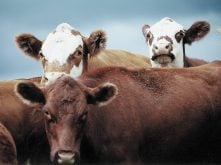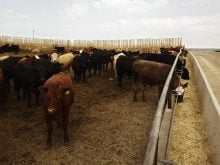This cattle market information is selected from the weekly report from Canfax, a division of the Canadian Cattle Association. More market information, analysis and statistics are available by becoming a Canfax subscriber by calling 403-275-5110 or at www.canfax.ca.
Range-bound fed market
The Alberta fed market has been range bound for 10 straight weeks. Dressed sales were marked at $390 per hundredweight delivered, and thin reported live trade was generally comparable.
The weighted average steer price closed the week at $232.53 per cwt. Heifer trade was limited, and a weekly price trend was not established.
Read Also

Pakistan reopens its doors to Canadian canola
Pakistan reopens its doors to Canadian canola after a three-year hiatus.
Last week’s cash basis was estimated at around -$23.24 per cwt. but failed to attract U.S. buying interest despite a softer Canadian dollar. More fed cattle are also being contracted or formula priced for the fourth quarter of 2023, and the cash market has recently lost leverage.
Western Canadian fed slaughter for the week ending Oct. 21 realigned 12 percent larger than the previous four-day week to 40,386 head. Year to date, western fed slaughter was down seven percent from the same week last year to 1,696,358 head.
Western Canadian steer carcass weights were three pounds larger than the previous week at 961 lb. but were 16 lb. lighter than the same week last year.
Fed cattle/cow exports to the United States for the four-day week of Oct. 14 were four percent larger than the previous week at 10,592 head and 14 percent larger than a year ago. Year to date, fed cattle/cow exports were down one percent to 376,196 head.
Packers are fighting an uphill battle to boost wholesale beef values to improve kill margins as price resistance at retail continues.
In the U.S., September feeder placements came in well above industry estimates so the early week cattle board plummeted, setting a softer tone for the cash-fed market. Southern live trade was generally steady to US$2 per cwt. lower than the previous week from $183-$185 per cwt. Most northern live sales were $1-$2 per cwt. lower than the previous week at $185-$186. Light dressed trade was $2-$3 per cwt. lower than the previous week’s Nebraska rail average at $291 per cwt. delivered.
Total U.S. slaughter last week was estimated mostly steady with the previous week at 636,000 head and five percent lower than a year ago.
Strong cow market
The big story for the second half of October is the strength of the butcher cow market because prices don’t usually strengthen at this time of the year. Non-fed volumes have seasonally increased, with some auction facilities reporting 600-1,000 head of slaughter cows at weekly sales and sometimes more.
Despite larger numbers, D2 cows traded $1.50 per cwt. higher this week to average $135.83 per cwt. and have gained $5 per cwt. over the past month. D3s averaged $122.35.
Western Canadian cow slaughter for the week ending Oct. 21 totalled slightly more than 8,000 head. For the second half of October, this is the largest slaughter since 2013.
Butcher bulls have struggled relative to the cow market. Last week, they traded steady and were at the lowest point since April. Over the past 20 years, butcher cow prices have only established fall price lows in October once, suggesting there is still downside price risk heading into November.
Huge auction volume
Over the past four weeks, Alberta auction volumes (sale ring and electronic) totalled slightly more than 307,000 head, 34,000 head larger than last year. For the month of October, this is the largest auction volume since 2005.
The combination of historically larger auction volumes, weakness in the futures market and poor weather conditions early last week caused logistics issues. It was a tough week for the calf and feeder market, with prices $10-$15 per cwt. lower.
Over the past five weeks, 550 lb. steer prices have declined $21 per cwt., while 550 lb. heifer calves have dropped $34 per cwt. over that same time.
After trading at a premium to the U.S. market for all of September and early October, Alberta calf prices have moved to a discount. The price slide between 450 lb. and 550 lb. steers has been historically wide over the past month, averaging $56 per cwt.
Last week bred cows traded from $2,000-$3,375 per head, averaging $2,500.
Cutouts up slightly
In U.S. beef trade, cutouts managed a small pop last week, Choice was at US$306.85 per cwt. and Select was at $279.69. Both closed around one percent higher than the previous week.














